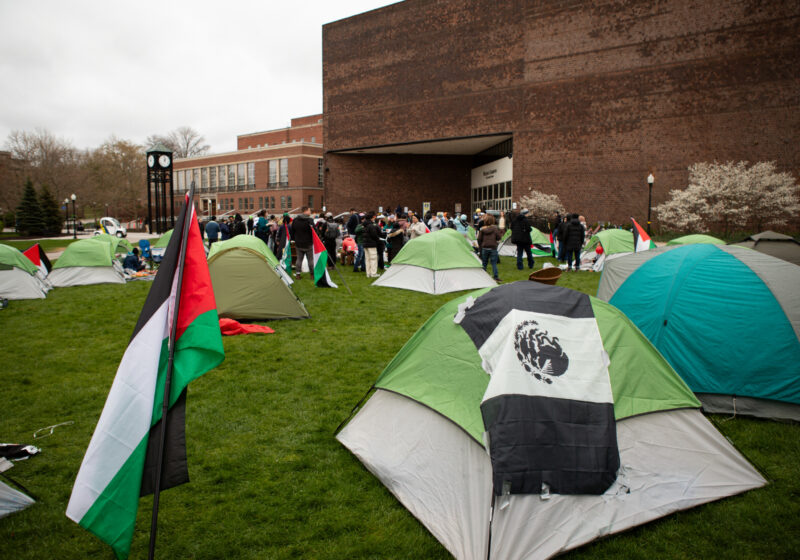Last year, I spent Halloween with a family in a difficult situation. I watched two exhausted parents sit around a small table covered with a yellow plastic tablecloth. Their two young daughters ran around the large, well-lit room, playing in their costumes as a witch and a princess. The parents’ faces wrinkled when they gave the children a faint smile, showing their age plus 10 years. There were others in the church basement watching the girls play. These families look different but share one thing. All of them have been evicted from their homes and, without the help of a caring faith community, would be living on the streets.
The Rochester Area Interfaith Hospitality Network (RAIHN) supports families like those I met on Halloween. The small, privately funded group is able to host up to five homeless families at one time, usually serving up to 30 families a year. The program is small and the number of requests for assistance is often four times what they are able to provide. Before receiving housing, families are screened by the director of the small organization to ensure they are a good fit for the program and will fit with the other families. If they are not accepted into RAIHN, the directors of the program try their best to find another shelter to send them to instead of putting them out on the street.
RAIHN is not just another homeless shelter, but is specifically for parents with children under the age of 18. Their housing is very different from a typical homeless shelter as well. The families are fed dinner and are put up for the night in the “host church” of the particular week. Air mattresses are set up in different rooms of the church for an attempt at privacy in such a difficult time. Churches that are part of RAIHN host families for three to four weeks a year. Volunteers are members of the host church or from surrounding churches. The volunteers make dinner for the family, set up their air mattresses in their rooms, and make the families feel at home.
A network like RAIHN was not invented over night. It took volunteers many months to work out the logistics of the program before it could finally begin accepting families on April 26, 2004. Now, the program consists of a few staff members and 1,500 volunteers from 46 faith communities around Rochester.
Last Halloween, two of these sensational volunteers, Marti Egers and Sarah Singel, were the most seasoned and experienced of all the volunteers. After a few conversations following church services, I found out they were some of the first volunteers the program had and were influential in the decision of First Universalist in becoming a host congregation. Both of these wonderful, kind women went on to become the co-coordinators for the RAIHN program at First Universalist.
They signed up for different reasons. Marti, who Singel calls the “heart and soul of the RAIHN project at First Universalist,” approached the information meetings for the formation of this new organization with skepticism. Marti voted in favor of the RAIHN program coming to her church and, after one host week, “was sold,” she said.
Even now, Marti, a thin, older woman with short grey hair and glasses, attends as many RAIHN volunteer trainings as she can.
Singel, another older member of First Universalist with long grey hair and a brilliant smile, said she joined as a way to get involved with the church when she was a brand new member. “I asked the minister what I could do in the way of social justice and was told about RAIHN,” she said. Both of these women are critical to the continuation of the program at First Universalist and therefore important members of the RAIHN family of volunteers.
As wonderful as all of the volunteers are, the program would not be possible without a few staff members leading the way. The RAIHN Day Center is where Nancy Elliott, the director of the program, spends most of her time. Elliott leads interviewing families for the program and making sure they get all the assistance they need in their search for a new home. She is also in charge of day-to-day life at the center. Families use the beige house on Meigs road as their landing base during the days. Children are picked up from the house on the school bus. Parents have access to the computers at the center to hunt for jobs and houses. Elliott and her staff also track families in their journey towards new housing.
“We meet with the families regularly to document their progress and decide next steps,” she said. “Sometimes we help them do a résumé or find jobs online. Sometimes they take online classes and we help them as needed.”
Working closely with Elliott is Jen Canning, the volunteer coordinator for RAIHN. Though she works out of her house on most days, she is still a critical part of the program. With her background in social work, Canning was prepared to take on the job at RAIHN last year. She began as a volunteer, coordinating her church’s program as the congregation established themselves as a host.
“I have a Masters in social work… and have experience managing programs staffed primarily with volunteers that served families that were homeless and families with young children,” she said when asked why she thought she was qualified for the job.
Both Canning and Elliott whole-heartedly believe in the mission of RAIHN to “assist homeless families to achieve sustainable independence by supporting them with tailored services including shelter, food, personalized case management, and a diverse network of caring volunteers.”There is no doubt in their minds that the need Rochester is great and continues to grow.According to their statistics, over 600 Rochester families sleep homeless every night. Though RAIHN is a very small program, it still makes a difference in the lives of the families they serve.Before volunteering for RAIHN, most of the host church volunteers are not aware of the great need for housing in Rochester. They might see one or two homeless people onthe street, pushing their shopping carts around, but the homeless are a much greater population than what is visibly apparent.
“Rochester is such a two-tiered city which is both a wonderful place to raise a family and yet is also the seat of horrible and widespread poverty,” Singal said. “We should do whatever we can to improve the situation.”
The families that are homeless often sleep in cars, even when the temperatures drop dangerously low in the winter months. They are often afraid that, if they seek help from one of the homeless shelters, they will be split up, often the only choice for many homeless families in Rochester. According to Canning, RAIHN is one of only three homeless shelters in the Rochester area that are able to keep families together.
“RAIHN fills a gap in services for homeless families that isn’t being filled by other shelter programs,” she said. “Because our program does not receive governmental funding, we do not have restrictions on who we serve or what constitutes a family unit. We serve single mothers with children, single fathers with children, two parent families, same sex couples with children, grandparents or other guardians with custody of children, and women who are at least eight months pregnant. Most importantly, we will take into our program families that include men and boys over 14 years old.”
She added that most shelters take only mothers and young children, leaving fathers and teenagers to find other housing on the streets. When volunteers are asked why they give up their weeknights and free weekend time to help the homeless, their answers were all very similar.
“I believe that every person has the power to make this world a better place, even if only by little steps and one person at a time,” Marti said. “There are so many problems in this world that I can’t help with, or can help very little with. Family homelessness is a serious local problem, and RAIHN gives me the opportunity to do a little part to provide a safe place for these families to relax, sleep ,and eat while they work toward returning home.”
The family I met last fall is now in stable housing. The children continue to go to school and will be able to grow up in an apartment instead of living out of their car. The best part of their story is that they were able to stay together as a family during some of the most difficult times in their lives. Because of RAIHN and the host churches, staff, and amazing volunteers, they made it through their struggles together and are now moving forward.
Sanguinetti is a member of the class of 2015.

